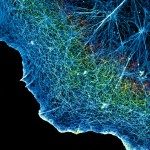Link to Pubmed [PMID] – 24460908
Biol. Cell 2014 Apr;106(4):111-25
BACKGROUND INFORMATION: Polycomb group (PcG) proteins keep the memory of cell identity by maintaining the repression of numerous target genes. They accumulate into nuclear foci called Polycomb bodies, which function in Drosophila cells as silencing compartments where PcG target genes convene. PcG proteins also exert their activities elsewhere in the nucleoplasm. In mammalian cells, the dynamic organisation and function of Polycomb bodies remain to be determined.
RESULTS: Fluorescently tagged PcG proteins CBXs and their partners BMI1 and RING1 form foci of different sizes and intensities in human U2OS cells. Fluorescence recovery after photobleaching (FRAP) analysis reveals that PcG dynamics outside foci is governed by diffusion as complexes and transient binding. In sharp contrast, recovery curves inside foci are substantially slower and exhibit large variability. The slow binding component amplitudes correlate with the intensities and sizes of these foci, suggesting that foci contained varying numbers of binding sites. CBX4-green fluorescent protein (GFP) foci were more stable than CBX8-GFP foci; yet the presence of CBX4 or CBX8-GFP in the same focus had a minor impact on BMI1 and RING1 recovery kinetics.
CONCLUSION: We propose that FRAP recovery curves provide information about PcG binding to their target genes outside foci and about PcG spreading onto chromatin inside foci.


